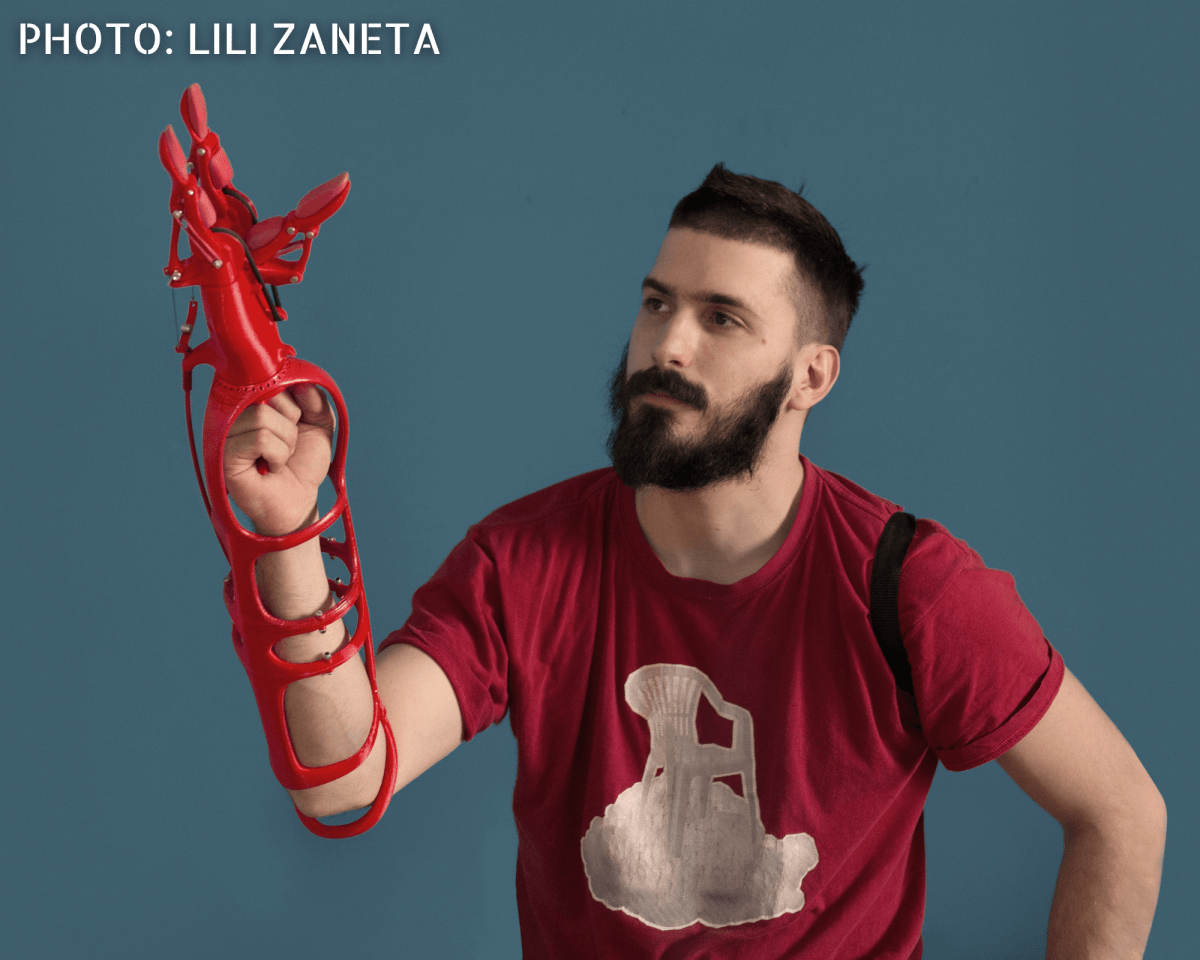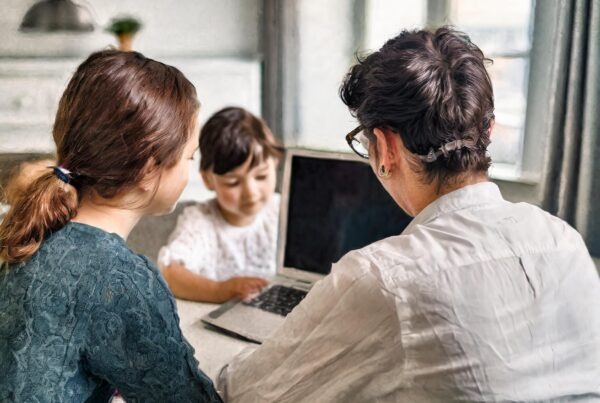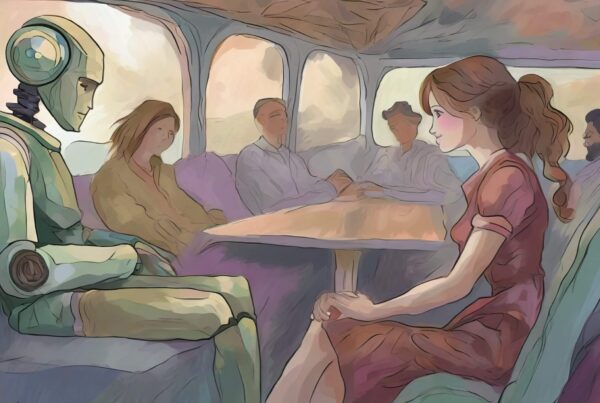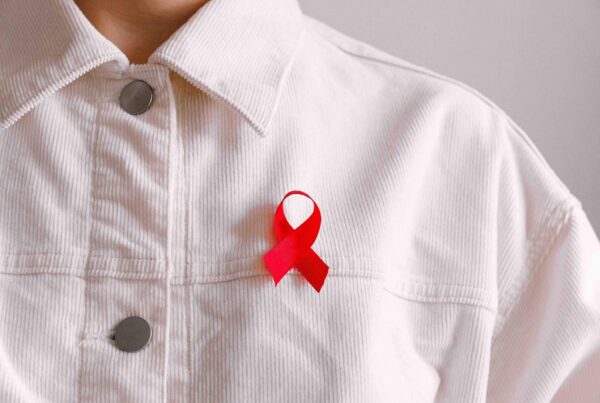Andrej Đukić, a Croatian product designer and founder of the hand prosthesis project “Maker Hand” won the international competition for prosthetic aids, Cybathlon of the ETH Zurich 2020. His ultimate goal is for people around the world to have access to free assistive technologies, from prostheses, orthoses to wheelchairs.
A commendable plan and a 3D printer – that is all Andrej needed to initiate a significant change for people with physical disabilities. What motivated him to launch his unique project, what was it like to take part in a competition in the middle of a pandemic and what he plans for the future? Find out in this intimate interview for WirHelfen.eu:
How did the idea of making prostheses come about, what inspired you to make them?
It’s actually a very personal story that developed, or to be more precise, is developing into a global project. I have played football my entire life. In college, I learned about wrestling and jiu-jitsu. The combination of these sports led to chronic cartilage damage in my right ankle, and to a lesser extent in the wrist of my right hand. Initially the ankle hurt terribly, so I started researching options and learned that there was really no good solution that would allow me to get back into the sport.
Reading the stories of people who had embarked on a journey of endless and unsuccessful surgery, I came across a British man who, after ten years of surgery and rehabilitation, finally decided to have his leg amputated and has lived without pain ever since. He was even able to return to sport. So I had the ‘stupid’ idea to amputate my leg and design a prosthesis for my thesis. And that’s where it all started…
“You can solve any problem with your hands, but if you don’t have a hand, or at least a working prosthetic, you can’t even help yourself.”
Andrej Đukić
One morning I experienced what I now call a ‘bad cartilage day’, something like a ‘bad hair day’, but much worse. My wrist and ankle hurt, so I spent the day in bed and was in a pretty bad mood. I thought about making myself a prosthetic leg, but my arm was in such a bad state that I couldn’t draw.
Somehow it dawned on me at that moment how tragic it would be to have no hands. Human hands are so magical, you can solve any problem with your hands, but if you don’t have a hand, or at least a working prosthetic, you can’t even help yourself.
After that, I started researching prosthetic arms on the internet and learned that they are actually much less powerful and sophisticated than the media and films portray them to be. Then I decided to design a mechanical arm.
Photo: Lili Zaneta
What makes your prosthetics stand out in comparison to others on the market?
First and most importantly, they are free for the users. To be more precise, in order to make them you only need a few hundred kuna for the material, a home 3D printer and a slightly more experienced “maker” who can follow the instructions on how to create and fit the prosthesis.
In fact, I have designed a mechanical arm that is functionally superior to the robotic arms and is created with the help of 3D printing, which significantly reduces the cost of its production.
What are the advantages of mechanical compared to robotic prostheses?
First of all, the price (the total cost of parts you will need to make one of your own – outside of the extremely cheap printing filament – is less than €25 and that will cover the cost of producing about a dozen Maker Hands, Andrej says, Ed. note). And then the functionality.
Mechanical hooks, developed during the First World War, are indeed still more functional in some situations than even the most expensive robotic arms, even though the focus of engineers in this field has been almost exclusively on the development of robotic arms for the last 60 years.
Prostheses cost from a few tens of thousands of kuna for mechanical hooks to several hundred thousand kuna and even more than a million kuna for robotic variants.
How does the production process unfold, how long does it take and how demanding is the fitting of each prosthesis to an individual user?
Fitting takes only a few hours in a 3D programme, while the prosthesis itself is printed on any home 3D printer and then assembled in an afternoon. However, the manufacturing time depends heavily on the experience and skill of the “maker”. The prosthesis was designed from the beginning to be as cheap and easy to produce as possible.
Photo: Marko Ercegovic
What material is it made of, and how does the prosthesis you developed work – how can the user move it?
The basic principle of the prosthesis is the same as the mechanical hook. By spreading the shoulder blades, the cable that opens the arm is tightened and strong rubber bands close it. In addition, the prosthesis has a unique design that allows the user to use the rotation of the forearm to turn the prosthetic hand itself.
Each finger can be closed individually and has an automatic locking system. The thumb can also be opened and can be locked in three positions. The fingers are covered with silicone that provides a secure but soft grip. The prosthesis is made of standard materials for 3D printing, and a few other elements that are easy to obtain, such as a bicycle brake, hairbands and such.
Photo: Marko Ercegovic
Who have you been able to help with your prosthesis so far?
I made the first working prototype of a mechanical arm to defend my dissertation. The first person, apart from me, to use a prosthesis was Hrvoje Kovač. He had to have his arm amputated due to an aggressive type of cancer. Unfortunately, Hrvoje passed away last year.
After I was admitted to the Cybathlon in Switzerland, I had to find my pilot. Then I met Krunoslav Mihić, who Maja Tomašević, a physiotherapist at the Clinical Institute for Rehabilitation and Orthopaedic Aids in Zagreb, put me in touch with. Kruno had lost his arm in an accident at the factory where he worked.
We had a little over a year until the competition and a lot of work. Then I made a 3D scan of his hand and started working on a prototype for the competition.
Photo: Marko Ercegovic
Two years ago I met little Dominik Nestić, who lost both hands in the accident. I made a prototype of the prosthesis for Dominik, but through interaction with him, I realised that the version at that time had too many problems.
As a result, I decided to completely redesign the prosthesis, and that’s how the Maker Hand became what it is today. Therefore, Dominik is most responsible for the current design and functionality of the Maker Hand prosthesis.
Take a look at how Dominik Nestić is using and benefiting from his Maker Hands in everyday life:
How did you decide to sign up for the Cybathlon?
While I was working on my dissertation, I discovered that the Cybathlon 2016, an international competition organized every four years by the renowned faculty of ETH Zurich, was held in a stadium in Switzerland. There, all the major prosthetic companies and research teams from universities around the world compete to demonstrate and prove the superiority of their prostheses.
At that time, I set myself a goal. I decided to compete in the next Cybathlon, scheduled for 2020, and win with my prosthesis, which will then be made by volunteers around the world for anyone who needs it.
Photo: Marko Ercegovic
What did the polygon that the participants had to go through look like, what had to be presented and how fast?
The Cybathlon competition itself consists of 6 tasks for which the competitor has only eight minutes. The first task is a kitchen activity such as opening a can, a jar, cutting a loaf of bread, etc. The second task is dressing, undressing and tying of the shoes. The third task is fine motor skills, the fourth is a home Improvement task like turning a light bulb, cutting paper with scissors and hammering a nail into a tree with a hammer.
The fifth task is a test of sensory perception through a prosthesis, where the participant has to feel the shape and material of the object hidden in the box. The last task is to assemble a pyramid from plastic cups. Only three teams managed to solve all the tasks in the given time, and we were one minute faster than the second-placed Italian team!
CYBATHLON 2020 Global Edition – ARM Finals:
How and for how long did you prepare for the competition?
Just when Kruno and I were planning to start training for the competition, the European lockdown started, so we couldn’t meet for a long time. I was living in the Netherlands, where I was studying, and Kruno was living in Nova Gradiška, Croatia. In the end, we only managed to train 40 hours for the competition, while some other participants have been using their prostheses for years.

Photo: Marko Ercegovic
How important is the recognition you received, and what does it mean for your further work?
More important than the recognition for me is that my prosthetics really help those who need them. But I would be dishonest if I didn’t say that I am proud because, by winning the Cybathlon, I proved that a high-quality, functional and useful prosthesis can be made for only a few hundred kuna!
You are also developing an online platform – can you explain its purpose and how it works?
I am currently working with wonderful people from FIVE, to whom I am immensely grateful for all the help so far. We are working on a global online platform where we teach volunteers who make 3D models how to make prosthetics through instructional videos and connect them with people who need prosthetics.
From the beginning, the prosthesis was designed to be made as cheaply as possible. So the materials for a prosthesis cost a few hundred kuna, and the prosthesis can be made in two days.
Do you think that in the future all types of prosthetics could become completely free for all users?
Definitely, I think it is unacceptable that in the twenty-first century people all over the world do not have access to the most modern prosthetics just for financial reasons.
What are your plans for the future? Do you plan to develop leg prostheses in addition to arm prostheses?
Yes, my goal is to develop prosthetic legs, and I hope one day to form a team of researchers to develop a whole range of prostheses and orthoses that volunteers could make using 3D printing and other widely available methods for people who need them.









